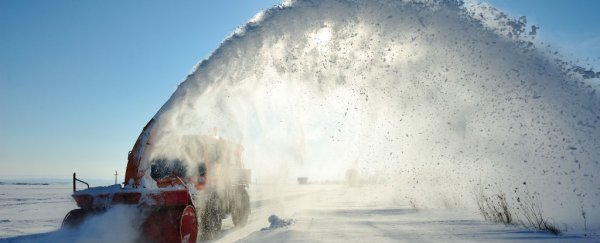Back in February, physicists announced an outlandish plan to 're-freeze' the Arctic, by installing 10 million wind-powered pumps over the ice cap to replenish the dwindling sea ice.
The idea was so wild, no one actually thought it would happen, but researchers in Switzerland have just launched a trial that will see if they can sustain an entire glacier through summer using nothing but snow machines.
If the team manages to successfully preserve a small, artificial glacier at the foot of the Diavolezzafirn glacier in the south-eastern part of Switzerland through the year's hottest months, it's hoped that they can apply the technique to the country's natural giant - the Morteratsch glacier.
One of the most massive glaciers in the eastern alps, this vast valley glacier has been retreating fast thanks to rising temperatures, and is currently losing 30 to 40 metres every year.
It could be that the only hope for Switzerland's Morteratsch glacier is thousands of snow machines blasting it with artificial sleet.
If all of this sounds a little far-fetched to you, scientists have actually done the maths, and it is technically feasible to use machines to rebuild glaciers and replenish vanishing sea ice.
Earlier this year, a team led by Arizona State University physicist, Steven Desch, put out a report describing how millions of wind-powered pumps could blast 1.3 metres of water on the surface of the Arctic, adding 1 extra metre (3.2 feet) of sea ice.
While an extra metre doesn't sound like all that much, they calculated that it would be like pushing time back by 17 years.
The only problem? How mind-bogglingly vast the Arctic region actually is.
The team calculated that covering just 10 percent of the Arctic would involve erecting millions of pumps, which together would have to spray 7.5 kg per of water (16.5 pounds) every second to achieve 1 extra metre in a year.
"The area of the Arctic Ocean is about 107 km2 [3.8 million miles2]," the report stated.
"If the wind-powered pumps are to be distributed across 10 percent of that area, this would necessitate about 10 million wind-powered pumps; if distributed across the entire Arctic, about 100 million would be needed."
In order to build a fleet of 100 million pumps to save the entire Arctic, you'd need more steel than the US produces in a entire year.
All that considered, there was no way in hell the plan was ever going to be funded, but the much smaller version proposed for Switzerland could actually have some legs.
Glacier expert Johannes Oerlemans of Utrecht University in the Netherlands calculated that around 4,000 snow machines could help the Morteratsch glacier not only stop retreating, but actually grow in the coming decades.
The basic idea is that the ice on the glacier is now being exposed to sunlight, but if they could cover the ice in thick, artificial snow, it could reflect the light away before it ever gets to the vulnerable ice layers below.
Oerlemans presented his plan at the recent annual meeting of the European Geosciences Union in Vienna, Austria.
"Looking at previous work showing that natural snow can help glaciers grow, he concluded that the glacier could regain up to 800 metres of length within 20 years if it had a covering," Andy Coghlan reports for New Scientist.
"He worked out that just a few centimetres of artificial snow blown onto a 0.5-square-kilometre plateau high up the glacier each summer could be enough to protect the ice beneath."
Of course, the plan isn't as colossal as the Arctic one, but it's still huge, and would require a lot of funding, but Oerlemans and his team are quietly confident.
For the past decade, the Diavolezzafirn glacier has been having artificial snow added to it over the winter months to improve the ski season. Locals in the area have seen as this extra snow helped the small glacier grow by up to 8 metres in the past 10 years, and they actually raised the US$100,000 needed to launch the trial run this summer.
If the trial successfully maintains the test section at the Diavolezzafirn glacier's foot through the summer months - the artificial snow usually melts down, only to be rebuilt for the return of the ski season later in the year - the team will need millions of euros to launch the actual Morteratsch rescue plan.
But the result could be revolutionary - it would be the first large-scale attempt to do something like this anywhere in the world.
With a major report coming out just last week, in which more than 90 scientists urged that the Arctic is "unravelling" as we speak, our only chance right now is to think big.
Let's hope we can find enough snow machines.
